Flowering Dogwood Trees and Shrubs: Types, Leaves, Bark – Identification (With Pictures)

Dogwoods are beautiful flowering deciduous trees and shrubs with distinctive flowers, berries, bark, and leaves. Most species of dogwood are fast-growing ornamental trees that are ideal for garden landscapes. Some types of dogwoods look like shrubs as they are small shrubby multi-stemmed plants. Flowering dogwood trees thrive in full sun and provide year-long interest in residential gardens.
This article is a comprehensive guide to the most popular and spectacular varieties of dogwood trees and shrubs. Descriptions and pictures of dogwoods will help identify the best trees for growing in your backyard.
Flowering Dogwood Trees
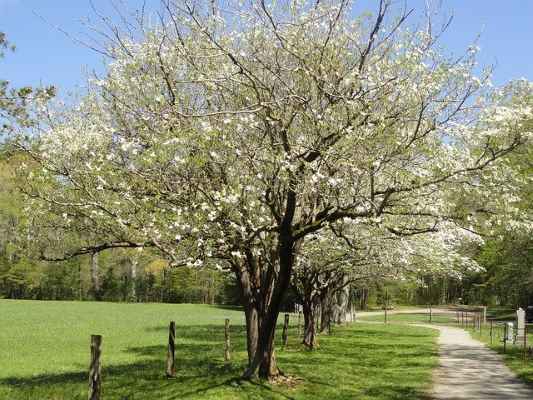
Flowering dogwood trees are small to medium size trees. They add decorative touch to any garden
Flowering dogwood trees are perennial species of woody plants belonging to the genus Cornus. Dogwood trees burst into life when they bloom in spring with clusters of flowers. Dogwood flowers are typically white, but some species produce yellow, pale red or pink blossoms.
Dogwood trees are small to medium-sized trees, growing between 10 and 25 ft. (3 – 7.6 m) tall. The flowering trees are typically single-trunk decorative trees with white spring flowers and green summer foliage that turn reddish-purple in the fall. The distinctive bark of dogwood trees makes these trees easy to identify.
Flowering dogwood trees have a fast growth rate. Dogwoods grow up to 1 ft. (30 cm) a year and can reach their full height within ten years.
To grow dogwood trees, plant them in partial shade or full sun. Dogwoods flower every spring and require well-draining soil that is always moist. Although the small decorative trees thrive in partial shade, they will grow well in full sun if you water them regularly.
One reason why flowering dogwood trees are popular is that they are low-maintenance garden trees. Most dogwood species have a rounded to flat crown that requires little—if any—pruning. After the large shrubs or small trees are established, you only need to water them regularly on hot summer days.
Dogwood Leaves
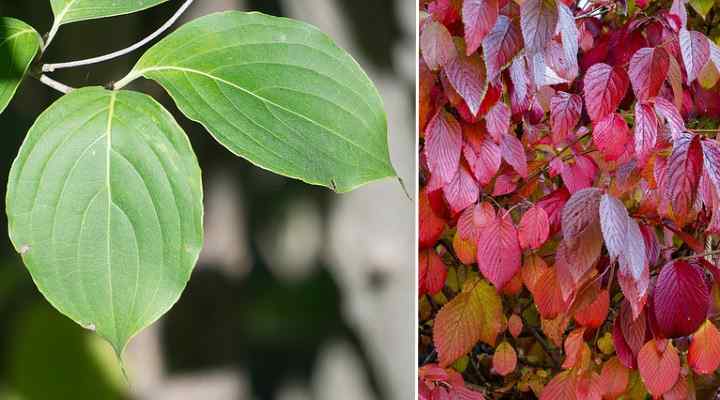
Dogwood leaves turn beautiful reddish color in autumn
Dogwood tree leaves are identified by their elongated oval shape, visible curving veins, and smooth edges. Dogwood leaves are classified as simple tree leaves that grow in an opposite arrangement on stems. However, some species of dogwood have leaves that grow alternately. Dogwood leaves measure 2” to 4” (5 – 10 cm) long, and the elongated rounded form tapers to a point.
Dogwood Bark

Scaly bark of flowering dogwood (Cornus florida)
Dogwood bark looks scaly, and it peels easily. Bark on flowering dogwood trees is one of its distinctive identifying features. On many varieties of dogwoods, the gray-brown bark has an unusual pattern resembling alligator skin. This is one of the dogwoods’ characteristics that give the tree appeal in a winter garden landscape.
Dogwood Flowers
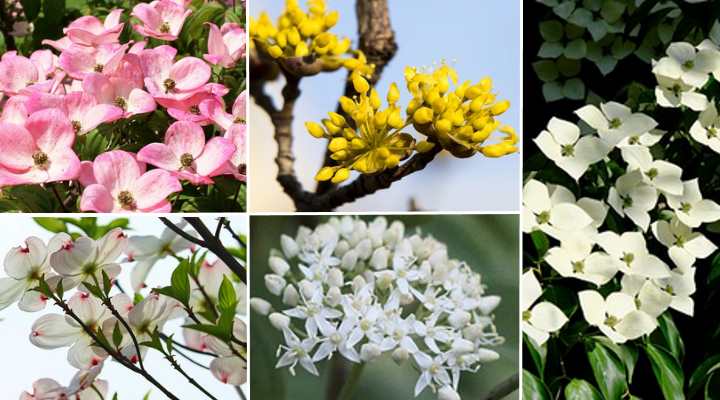
Dogwood flowers are usually white, but can also be pink or yellow
Most dogwood trees produce white flowers, however it can vary from species to species. Some dogwood types produce pink and yellow flowers.
Some dogwood varieties have tiny yellowish-green inconspicuous flowers surrounded by large white petal-like bracts. Other dogwood types have larger and more open clusters of petals.
Flowering dogwood trees bloom from mid-March through May. The masses of white flowers contrast with light green foliage to create a magnificent shade tree.
Dogwood Berries

Dogwood berries. Left to right: Fruits of Cornus mas, C. alba ‘Sibirica’, C. kousa, and C. sanguinea)
Dogwoods trees produce berry-like fruit in various colors, shapes and sizes. Some dogwood berries look like bright scarlet-red grape-like fruits growing in tight clusters. Others can be purple-black or white.
Some species of dogwood trees have poisonous berry-like drupe, and some are edible. So, if you have a dogwood tree growing in your backyard and you don’t know its species, you shouldn’t consume the drupes. The “berries” on dogwood trees attract birds and small mammals.
Dogwood Identification
Dogwood trees are easy to recognize due to their characteristic bark, smooth oval leaves, and white flower clusters. To identify dogwood trees, look for their hard, grayish bark that looks like alligator skin. Then, see if the leaves are elongated oval shapes with smooth edges and a pointed tip. Also, pronounced curved veins are very distinguishable on dogwood leaves.
Types of Flowering Dogwood Trees (With Pictures)
Flowering dogwood trees are popular ornamental trees for residential garden landscapes. Let’s look in more detail at some of the best dogwood trees for growing in front or backyards.
Flowering Dogwood (Cornus florida)
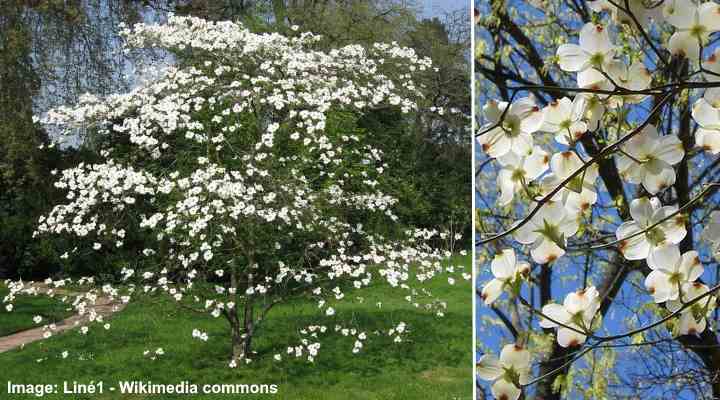
Flowering dogwood (Cornus florida) tree and flowers
Flowering dogwood is the common name for the species Cornus florida. Flowering dogwood tree has clusters of greenish-yellow flowers surrounded by large, broad, rounded white petals which are actually bracts (modifies leaves). Some species of tree produce pinkish or red petals, making the flowering tree even more attractive. After flowering, red inedible fruits appear.
The flowering dogwood tree is a small- to medium-sized deciduous tree growing between 10 and 30 ft. (5 – 10 m). A characteristic feature of this dogwood species is its flat, slightly rounded crown. The spread of the crown is usually more expansive than the tree is tall. Flowering dogwoods thrive in USDA zones 5 through 9.
When masses of flowers bloom during April and May, the dogwood is a stunning tree in backyards. Many people rate flowering dogwoods as the most appealing of all the native North American flowering trees.
The flowering dogwood (Cornus florida) is the state tree of Virginia and Missouri.
Dogwood bark: Flowering dogwood tree bark is dark brown or gray, growing in square patterns surrounded by deep ridges. The dogwood bark has a distinct scaly appearance.
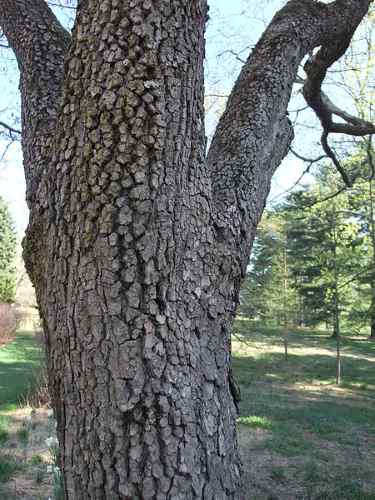
Flowering dogwood tree bark
Dogwood leaves: Flowering dogwood tree leaves are oval-shaped with delicate noticeable veins. Leaves on this dogwood species grow in an alternate leaf arrangement.
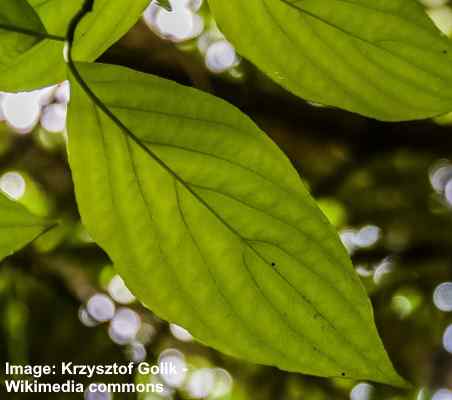
Flowering dogwood leaves
Kousa Dogwood / Japanese Dogwood (Cornus kousa)
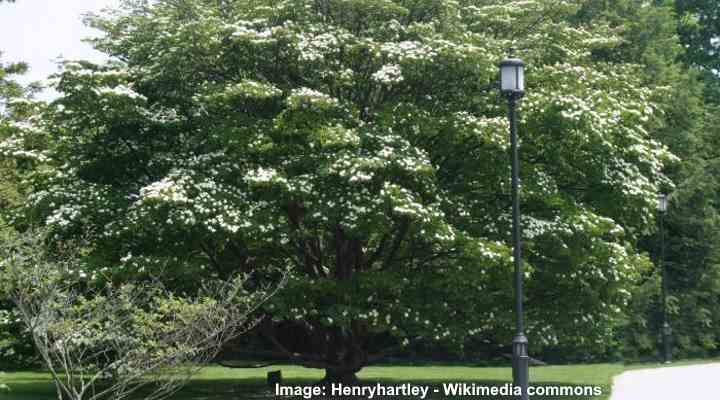
Japanese dogwood (Cornus kousa) tree
The Kousa dogwood tree is a small to medium flowering shade tree that produces multitudes of large white star-shaped flowers in spring. In summer, the Kousa dogwood grows dense green foliage that turns bright red in the fall. This tree’s visual appeal is its attractive smooth exfoliating bark growing in brown, tan, and gray patterns in winter.
Other names for the Kousa dogwood tree are Japanese dogwood or Chinese dogwood. The small-medium tree grows between 15 and 30 ft. (4.5 – 10 m) tall. The horizontal branching creates an attractive rounded crown of oval, pointed leaves. The green foliage turns a spectacular bright red in the fall.
The Cornus kousa ‘Greensleeves’ is a variegated variety of dogwood with bright yellow and green colors. The ‘Lustgarten Weeping’ Kousa dogwood is a beautiful ornamental tree with a drooping growth habit.
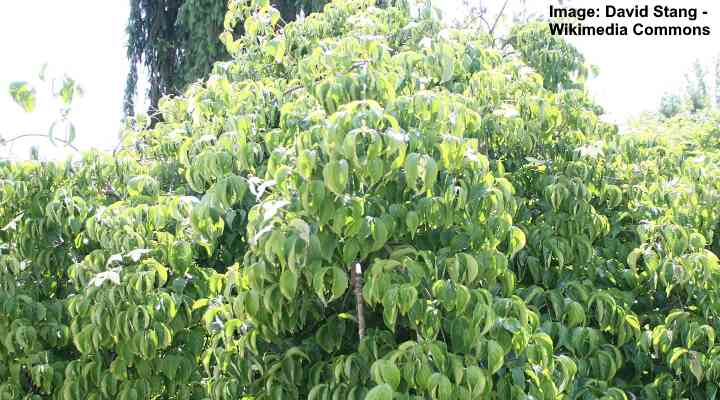
Cornus kousa ‘Lustgarten Weeping’
Dogwood bark: Kousa dogwood tree bark is thin and smooth that peels to give the bark a distinctive mottled appearance.

Japanese dogwood bark
Dogwood leaves: Kousa dogwood tree leaves are dark green and elliptic-ovate-shaped, growing up to 4” (10 cm) long and wide. Leaves grow in an opposite arrangement on branches.
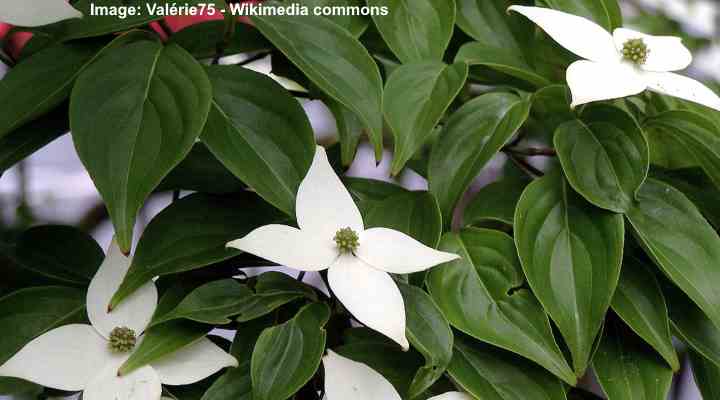
Japanese dogwood leaves and flowers
Pagoda Dogwood (Cornus alternifolia)

Pagoda dogwood – Cornus alternifolia ‘Argentea’ and Pagoda dogwood flowers
The pagoda dogwood is a large flowering multi-stemmed shrub or small tree. Pagoda dogwoods have clusters of small creamy-white-colored flowers growing in a flowerhead. A distinctive feature of the pagoda dogwood species is the layered horizontal branches with upturned tips. After flowering, small black drupes on red stalks appear.
The pagoda dogwood grows between 15 and 25 ft. (4.5 – 7.6 m) tall. Mature pagoda dogwoods have a flat-topped crown. Flowering multi-stemmed pagoda dogwood shrub or small tree, grows best in partial shade to full sun as long as the ground drains well and is kept moist.
Dogwood bark: Pagoda dogwood bark is brownish-gray and develops shallow vertical ridges as it matures.
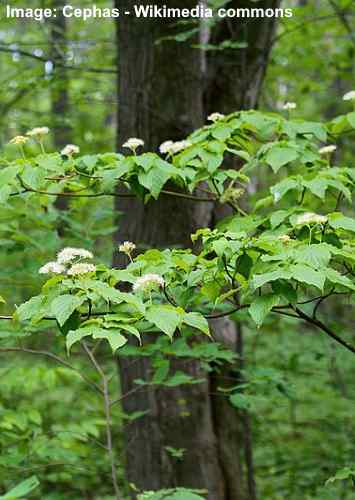
Pagoda dogwood bark
Dogwood leaves: Pagoda dogwood leaves are bright green with pronounced veining stretching to the smooth edges. In the fall, the attractive large leaves turn a golden yellow color.
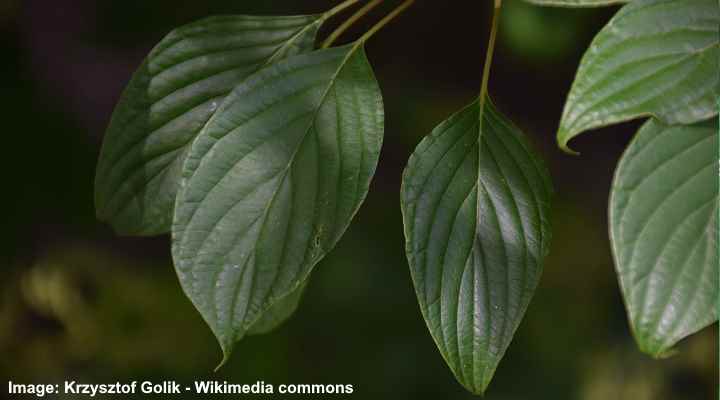
Pagoda dogwood leaves
Cornelian Cherry Dogwood (Cornus mas)

Cornelian cherry dogwood (Cornus mas)
The Cornelian cherry dogwood species is a small flowering tree or medium to large deciduous shrub with tiny flowers, green oblong leaves, and red berries. Compared to other species of dogwood, the Cornelian cherry doesn’t have showy spring flowers. However, the dogwood blooms into life in later winter, producing clusters of yellow flowers before the leaves appear.
Also called the European cornel dogwood, Cornelian cherry dogwood grows between 16 and 40 ft. (5 – 12 m) tall. Growing as a large shrub, Cornelian cherry dogwoods are ideal if you want to plant them as a flowering hedge plant or screen.
After the small yellow flowers finish blooming, red edible fruits appear. Although the fruits look like large berries, they are drupes similar to cherries.
Dogwood bark: Cornelian cherry dogwood bark is rough and scaly that peels to create orange and brown patterns.

Cornelian cherry dogwood bark
Dogwood leaves: Cornelian cherry dogwood leaves grow up to 5” (12 cm) long in an oblong shape. The dark-green leaves turn a dark purple color in the fall.
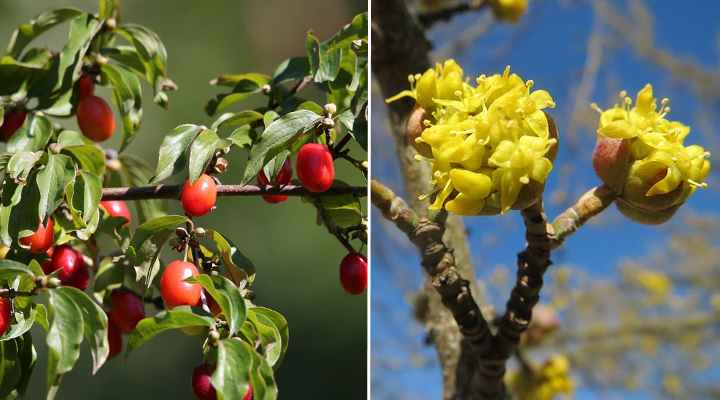
Cornelian cherry dogwood leaves, fruits and flowers
Mountain Dogwood (Cornus nuttallii)
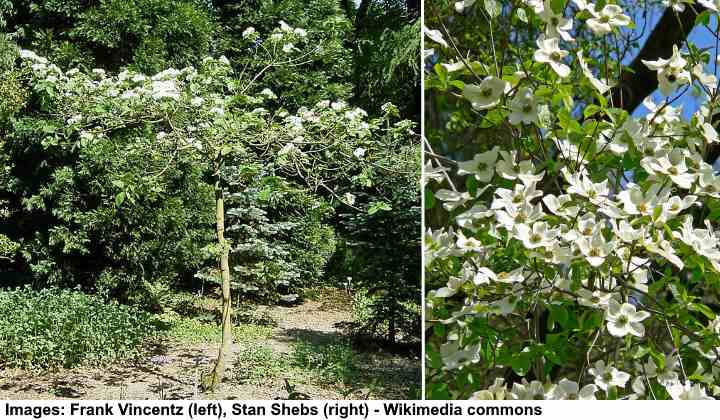
Young tree of mountain dogwood and flowers
The Mountain dogwood is a medium-sized flowering tree that produces large star-shaped flowers and has broad oval leaves. The small- to medium-sized dogwood tree has a rounded crown that is attractive in all seasons. In spring, the Mountain dogwood is covered in white flowers, then in summer, dark green foliage, before turning spectacular orange and red color in the fall.
Mountain dogwood trees grow between 15 and 40 ft. (4.5 – 12 m) tall. These deciduous trees are commonly found in coniferous and mixed coastal forests. However, the beautiful dogwood is also popular as a specimen tree in garden landscapes.
Mountain dogwood trees are native to the Western United States and related to the Cornus florida tree.
Dogwood bark: Mountain dogwood tree bark is smooth and gray with patches of white. The exfoliating bark peels in places.
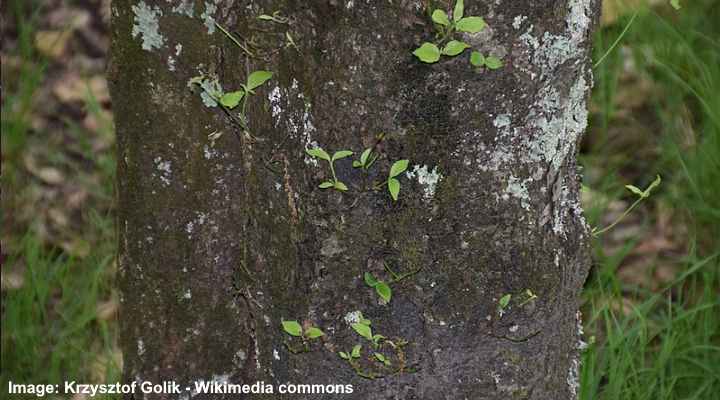
Mountain dogwood bark
Dogwood leaves: Mountain dogwood tree leaves are large elongated oval, glossy green leaves with pronounced veins. The simple leaves grow oppositely on stems.
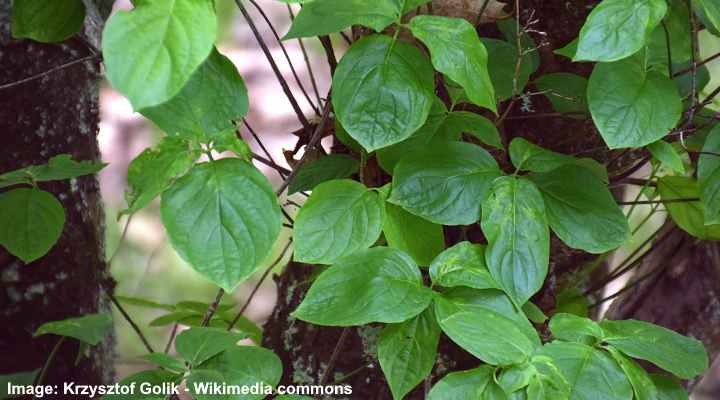
Mountain dogwood leaves
Giant Dogwood (Cornus controversa)
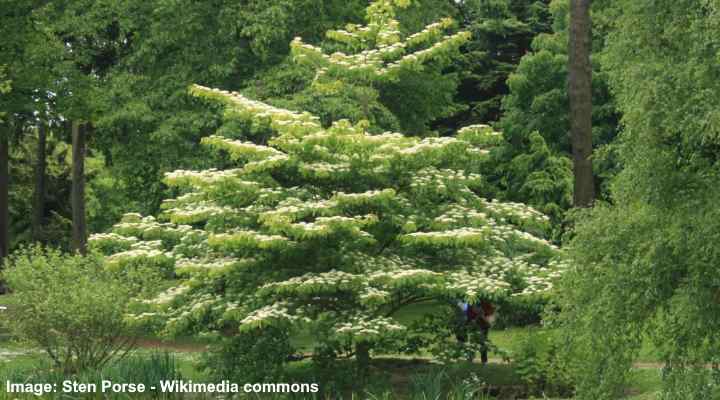
Giant dogwood (Cornus controversa) tree
Giant dogwood trees are medium-sized deciduous trees with a rounded growth habit. The horizontally-growing branches produce clusters of creamy-white flowers and large ovate shiny green leaves. These magnificent dogwood trees grow up to 40 ft. (12 m) tall with a similar size spread.
Dogwood bark: Giant dogwood tree bark is greenish-brown or gray with a smooth feel and shallow veins.
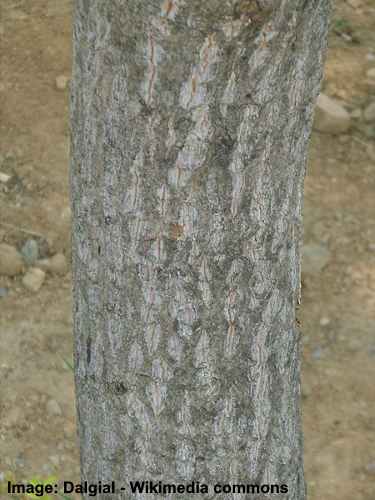
Giant dogwood bark
Dogwood leaves: Giant dogwood tree leaves are broad oval leaves up to 6” (15 cm) long. Leaves on giant dogwood stems grow in an alternate arrangement.
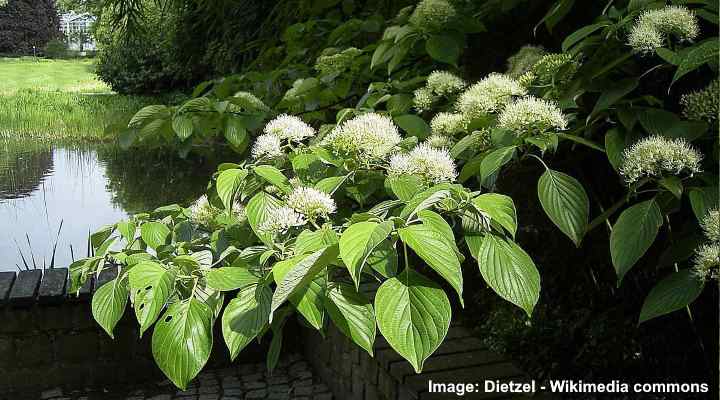
Giant dogwood leaves and flowers
Wedding Cake Tree — Giant Dogwood (Cornus controversa ‘Variegata’)
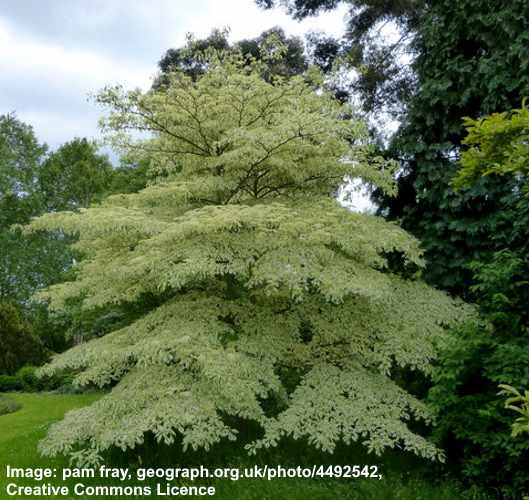
Wedding cake tree (Cornus controversa ‘Variegata’)
The variegated giant dogwood tree is one of the most stunning dogwood trees for gardens. The single-stemmed tree has a slender trunk with a spreading rounded canopy of layered branches. In spring, showy white flowers appear to create an eye-catching floral display. The ovate leaves are light green with creamy-white edges.
Wedding cake dogwood trees are smaller than the giant dogwood species tree and grow up to 25 ft. (8 m) tall.
Dogwood bark: The wedding cake tree has smooth greenish-gray bark with shallow grooves.
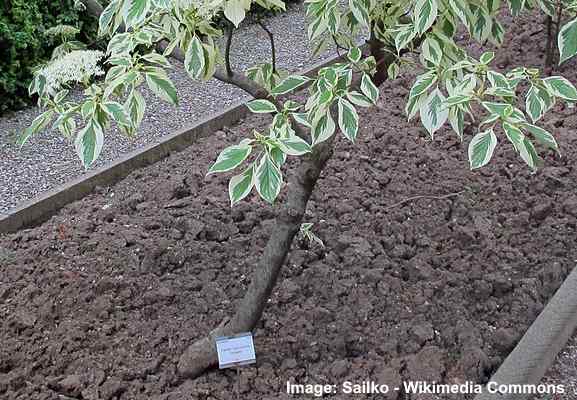
Bark of a young wedding cake tree
Dogwood leaves: The wedding cake tree leaves are ovate-oblong with dark green centers surrounded by cream-colored margins. These dogwood leaves have a somewhat wrinkled look.
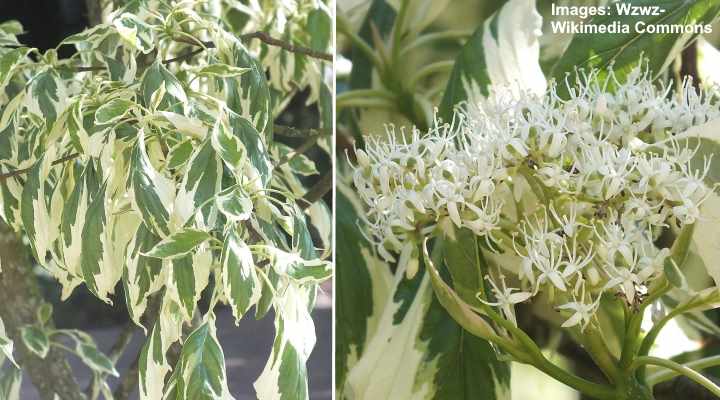
Wedding cake tree leaves and flowers
Evergreen Dogwood (Cornus capitata)
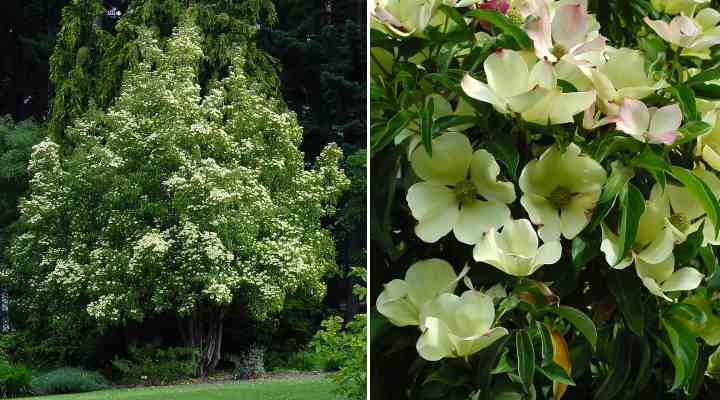
Evergreen dogwood (Cornus capitata) tree and flowers
The evergreen dogwood tree is an ornamental tree that grows up to 40 ft. (12 m) tall. Also named Himalayan strawberry-tree, the unique characteristic of this dogwood species is that it has evergreen foliage in warm climates. Fragrant creamy-white flowers bloom in spring and summer. After flowering, evergreen dogwoods produce sweet, edible red berry-like fruits.
Dogwood bark: Evergreen dogwood tree has brown-gray bark with shallow scales.
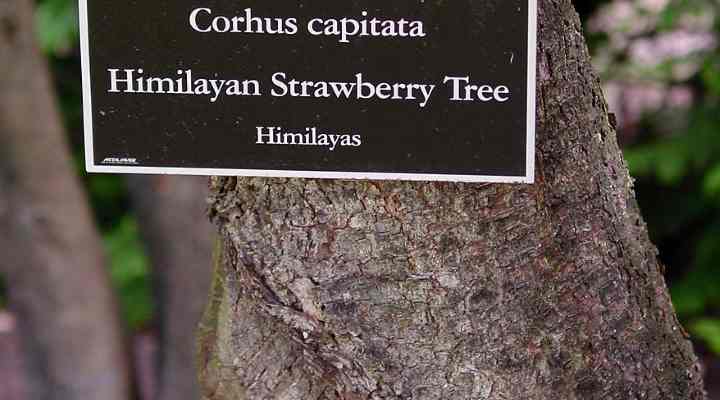
Evergreen dogwood bark
Dogwood leaves: Evergreen dogwood leaves are dull green and may turn reddish in autumn. They are ovate to lanceolate, 3 – 4.7″ (8 – 12 cm) long, and arranged in opposite pairs.
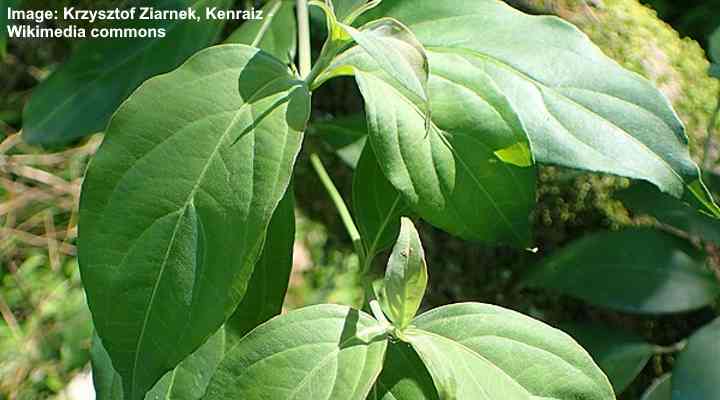
Evergreen dogwood leaves
Roughleaf Dogwood (Cornus drummondii)
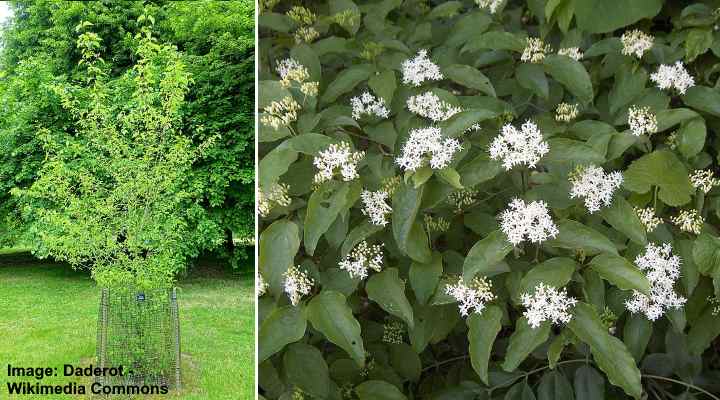
Roughleaf dogwood (Cornus drummondii) young tree (left), leaves and flowers (right)
The roughleaf dogwood tree is a small flowering tree with dark green oblong, pointed leaves and white summer flower clusters. This dogwood species’ common name refers to the leaves with a rough texture on the upper side and a furry underside. The flowers on roughleaf dogwoods don’t have the showy white bracts of some popular garden dogwoods.
Cornus drummondii grows between 15 and 25 ft. (4.6 – 7.6 m) tall. Some say that the leaves of roughleaf dogwood give off a sour milk scent.
Dogwood bark: Roughleaf dogwood tree bark is smooth and grayish-brown on immature trees. As the dogwood matures, the bark becomes scaly and flaky before developing into block-like patterns.
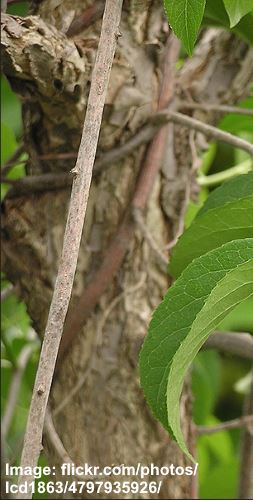
Roughleaf dogwood bark
Dogwood leaves: Roughleaf dogwood tree leaves have an oval shape with a rounded base and pointed tip. The simple leaves grow in an opposite arrangement on reddish-colored or green stems.
Types of Small Flowering Dogwood Trees or Shrubs (With Pictures)
Dogwoods are generally small to medium-sized flowering trees. However, some varieties of dogwood have a relatively short or dwarf growing size, and some of them have shrubby growth habit. This makes small dogwood trees or shrubs suitable for compact gardens or for growing as a lawn plant.
Here are some of the types of small dogwood trees or shrubs.
Red Twig Dogwood (Cornus alba)
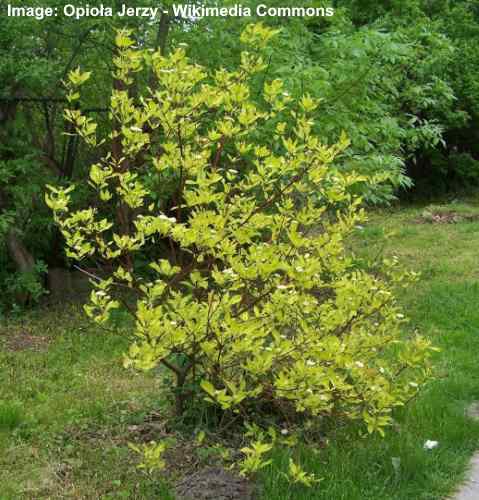
Red twig dogwood (Cornus alba)
Red twig dogwood is a small flowering tree or large shrub. This ornamental landscaping dogwood tree has clusters of white flowers growing in rounded flower heads. The lime-green oblong-ovate leaves have prominent veins that stretch toward the pointed tips. One of the outstanding features of Cornus alba is its spectacular red winter bark.
Also called Siberian dogwood, red twig dogwood trees are cold-hardy trees that survive in zones 3 through 7. Red twig dogwoods grow up to 10 ft. (3 m) high. Although they are classed as a small tree, most specimens grow as multi-stemmed shrubs.
Dogwood bark: Red twig dogwood plants have thin stems that become bright red in late fall and winter.
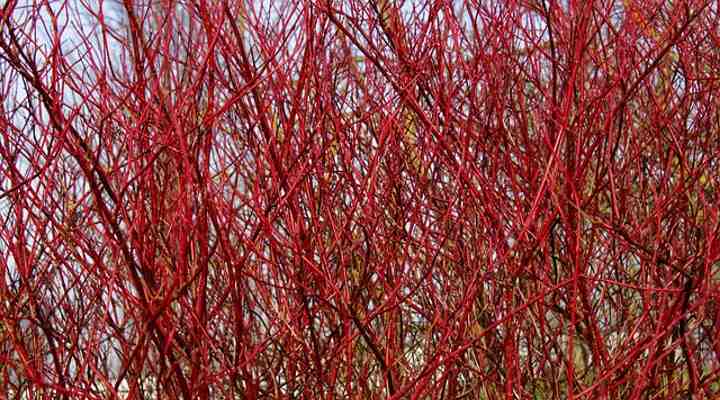
Cornus alba ‘Sibirica’ red twigs in winter
Dogwood leaves: Red twig dogwood plant leaves are ovate to lanceolate with a rounded base and smooth margins. The simple shrub leaves grow in an opposite arrangement on twigs.
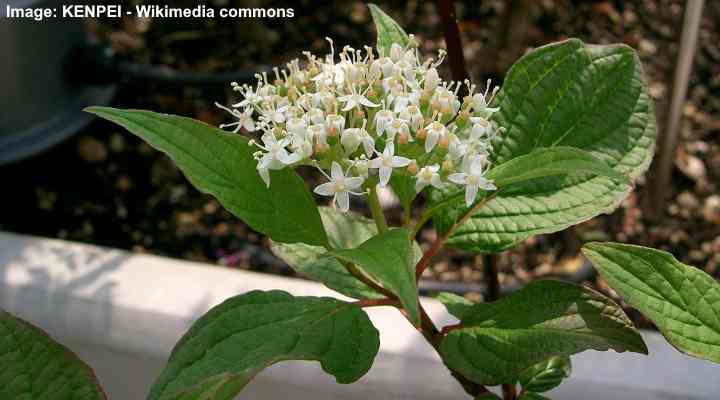
Cornus alba ‘Sibirica’ leaves and flowers
‘Wolf Eyes’ Japanese Dogwood (Cornus kousa ‘Wolf Eyes’)

‘Wolf Eyes’ Japanese dogwood leaves
‘Wolf Eyes’ dogwood is a small tree or multi stemmed shrub which is a smaller cultivar of the popular Cornus kousa tree. This multi-trunk, small flowering dogwood has a vase-shaped growth that gradually becomes rounded. As a small tree or large shrub, the ‘Wolf Eyes’ Japanese dogwood grows up to 10 ft. (3 m) tall. The distinctive feature of this small dogwood is the pinkish-white flowers with pointed white petals (bracts).
Dogwood bark: ‘Wolf Eyes’ Japanese dogwood bark is scaly and exfoliating. The grayish bark peels off to reveal tan or orange patches underneath.
Dogwood leaves: ‘Wolf Eyes’ Japanese dogwood leaves are variegated lance-shaped leaves with green centers and ivory-colored wavy margins.
Stiff Dogwood (Cornus foemina)

Stiff dogwood (Cornus foemina)
Stiff dogwood is a small flowering tree or large shrub with multiple trunks. The dogwood plant has dark glossy green foliage made up of pointed oval leaves. Clusters of tiny white flowers bloom in spring and summer before producing dark blue drupes. Stiff dogwood trees grow up to 15 ft. (4.5 m) high.
Flowers from stiff dogwood trees give off an unpleasant smell.
Dogwood bark: Stiff dogwood tree bark is brown to gray that exfoliates to reveal interesting patterns on the straight, slender trunks.
Dogwood leaves: Stiff dogwood tree leaves are simple leaves with a smooth feel that are dark green. The long, lanceolate leaves turn a deep red or purple color in the fall.

Stiff dogwood leaves and flowers
Bloodtwig Dogwood (Cornus sanguinea ‘Midwinter Fire’)
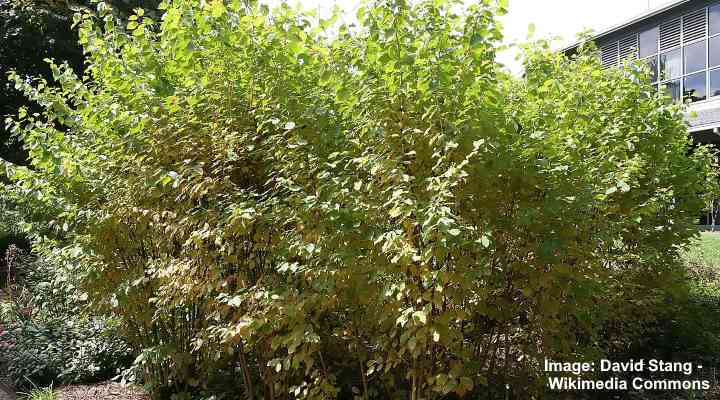
Bloodtwig dogwood (Cornus sanguinea ‘Midwinter Fire’)
Also called common dogwood, bloodtwig dogwood is a large ornamental shrub with fiery colored twigs and stems. Bloodtwig dogwood shrubs grow between 7 and 20 ft. (2 – 6 m) tall. This shrubby plant has clusters of small white flowers, oval-pointed leaves, and distinctive red bark. Bloodtwig dogwood grows in warm sunny locations and is native to Europe.
Dogwood bark: Bloodtwig dogwoods are multi-stemmed shrubs with stiff branches covered with red-colored bark.
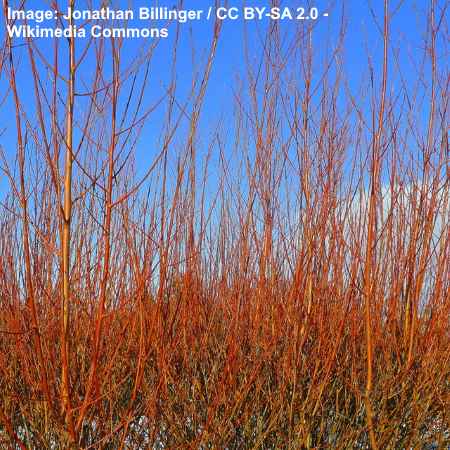
Bloodtwig dogwood twigs in winter
Dogwood leaves: Bloodtwig dogwood leaves have distinctive curved veins in the ovate green leaves. As with all species of dogwood, the leaves have smooth margins and a pointed tip.
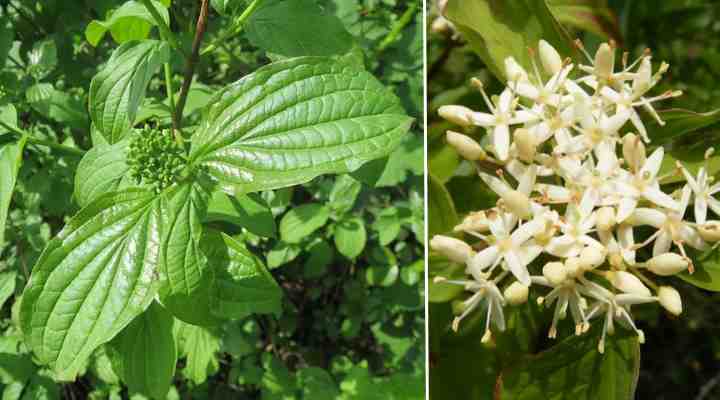
Bloodtwig dogwood leaves and flowers
Red Osier Dogwood (Cornus sericea)

Red osier dogwood (Cornus sericea) shrub
Red osier dogwood is a common ornamental multi-stemmed shrub that provides decorative element with its red twigs in the winter. Also called red willow, redstem dogwood or red twig dogwood, red osier is a fast growing medium to large sized deciduous shrub that grows 5 – 13 ft. (1.5–4 m) tall and 10 – 16 ft. (3–5 m) wide. It spreads quickly by underground runners, so make sure to remove them to control spread.
The flowers of red osier dogwood are small and white and grow in clusters. The fruit is a round attractive white berry, 0.2 – 0.35″ (5–9 mm) in size.
Red osier dogwood requires well-draining, rich moist soil, and grows well in full sun or partly shaded areas.
Dogwood bark: Red osier dogwood twigs have bark with beautiful reddish color which adds a focal point during winter time.
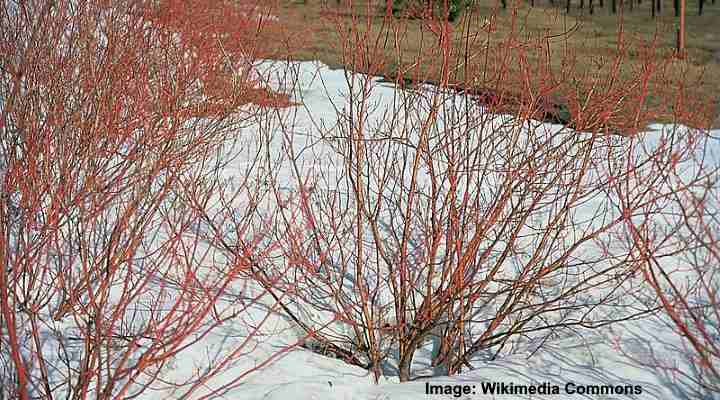
Red osier twigs in winter
Dogwood leaves: Red osier dogwood leaves are dark green with paler dull green underside and are 2 – 4.7″ (5–12 cm) long. The dogwood leaves are ovate to oblong shape and grow opposite. During autumn the leaves turn red-purple in color.
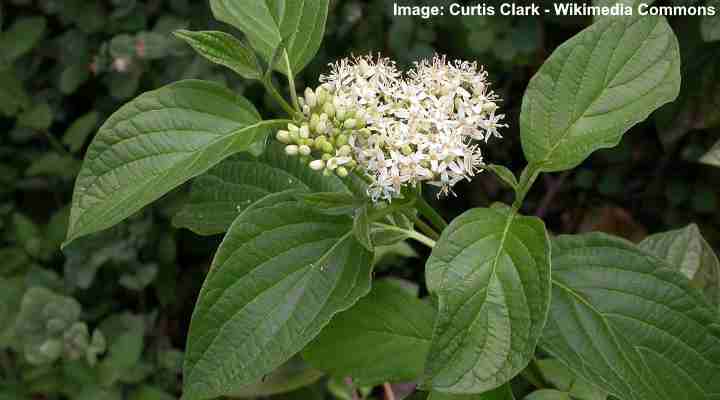
Red osier leaves and flowers
Gray Dogwood (Cornus racemosa)

Gray dogwood (Cornus racemosa) shrub
Gray dogwood is a large deciduous shrub that is also called northern swamp dogwood and panicle dogwood. This shrubby dogwood has a rounded habit and it spreads through underground rhizomes that send up suckers.
Gray dogwood typically grows 10 – 15 ft. (3 -4.5 m) tall, with similar spread. This dogwood shrub has dark green leaves that turn reddish-purple in autumn. The small white flowers are grown in rounded clusters, and they give way to immature green fruits that turn white when ripened.
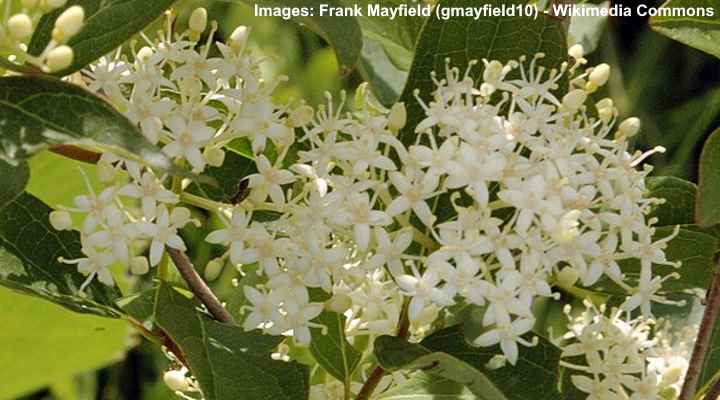
Gray dogwood flowers
Dogwood bark: New bark of gray dogwood is tan-brown that turns to gray as the twigs mature.
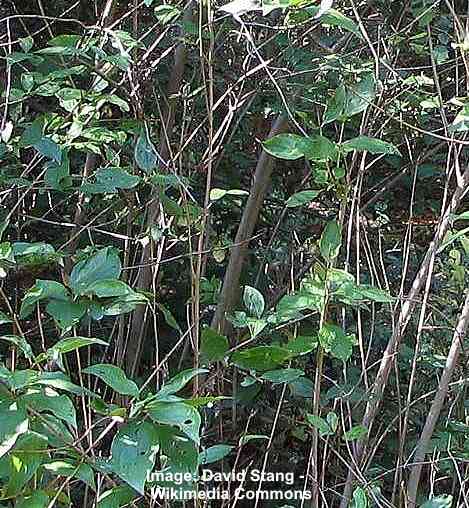
Gray dogwood bark
Dogwood leaves: Gray dogwood has green leaves that are lance-shaped and have fewer veins than other dogwood species. The dogwood leaves are oppositely arranged and are 1.5 – 3.2 “(4–8 cm) long.
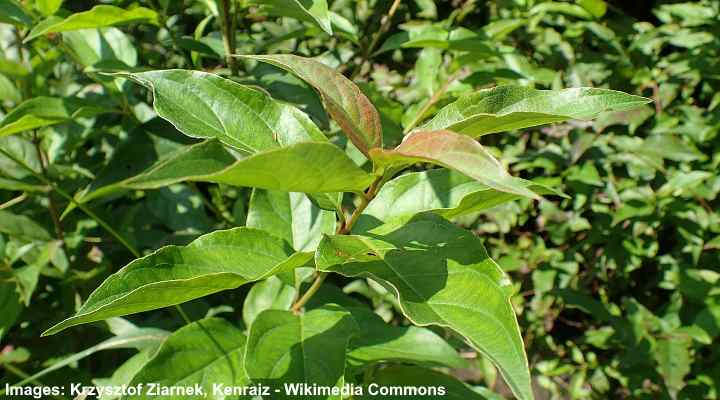
Gray dogwood leaves
Related articles:
- Small Trees for Landscaping Small Spaces
- Types of Redbud Trees with Pictures
- Types of Cherry Blossom Trees
